一般问句转换
- 格式:doc
- 大小:21.00 KB
- 文档页数:3
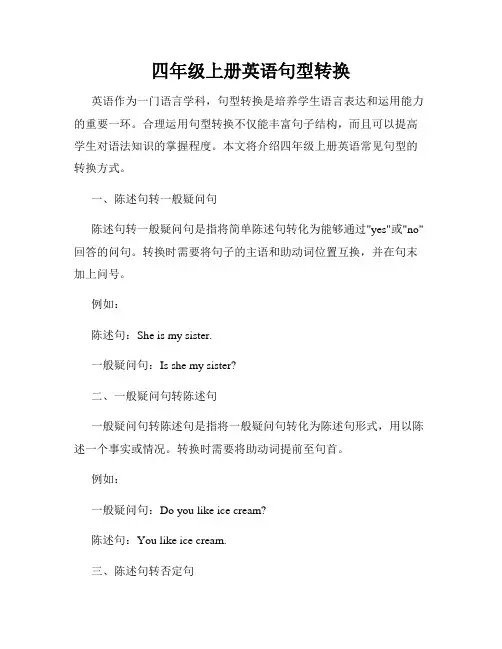
四年级上册英语句型转换英语作为一门语言学科,句型转换是培养学生语言表达和运用能力的重要一环。
合理运用句型转换不仅能丰富句子结构,而且可以提高学生对语法知识的掌握程度。
本文将介绍四年级上册英语常见句型的转换方式。
一、陈述句转一般疑问句陈述句转一般疑问句是指将简单陈述句转化为能够通过"yes"或"no"回答的问句。
转换时需要将句子的主语和助动词位置互换,并在句末加上问号。
例如:陈述句:She is my sister.一般疑问句:Is she my sister?二、一般疑问句转陈述句一般疑问句转陈述句是指将一般疑问句转化为陈述句形式,用以陈述一个事实或情况。
转换时需要将助动词提前至句首。
例如:一般疑问句:Do you like ice cream?陈述句:You like ice cream.三、陈述句转否定句陈述句转否定句是指将肯定句变为否定句。
转换时需要在动词前加上否定词"Not"或其缩写形式"don't/doesn't"。
例如:陈述句:He goes to school.否定句:He doesn't go to school.四、反义疑问句反义疑问句是指在陈述句的基础上构成一个根据前面句子意义相反的疑问句。
转换时需要根据主句的情态动词或助动词来选择反义形式,并在句末加上问号。
例如:陈述句:You like apples, don't you?反义疑问句:You don't like apples, do you?五、选择疑问句选择疑问句是指在陈述句的基础上构成一个提供两个或多个选择的疑问句。
转换时需要在陈述句后使用or连接两个或多个选项,并在句末加上问号。
例如:陈述句:She can swim in the pool.选择疑问句:Can she swim in the pool or in the sea?六、特殊疑问句特殊疑问句是指用来询问特定事物或情况的句子,一般以疑问词开头。
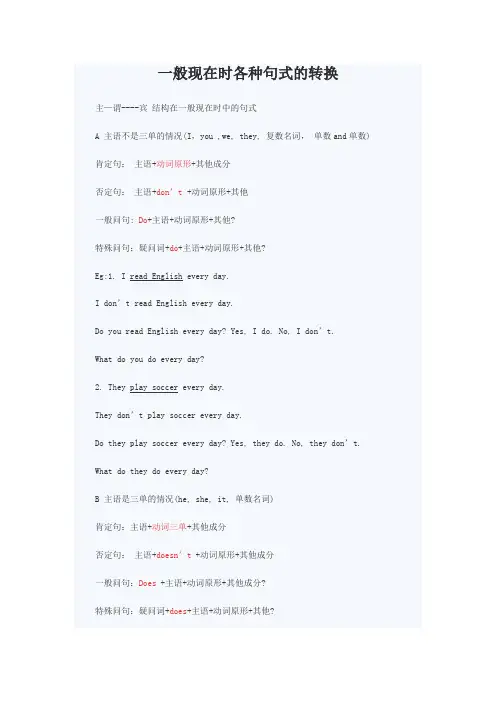
一般现在时各种句式的转换主—谓----宾结构在一般现在时中的句式A 主语不是三单的情况(I,you ,we, they, 复数名词,单数and单数) 肯定句:主语+动词原形+其他成分否定句:主语+don’t +动词原形+其他一般问句: Do+主语+动词原形+其他?特殊问句:疑问词+do+主语+动词原形+其他?Eg:1. I read English every day.I don’t read English every day.Do you read English every day? Yes, I do. No, I don’t.What do you do every day?2. They play soccer every day.They don’t play soccer every day.Do they play soccer every day? Yes, they do. No, they don’t. What do they do every day?B 主语是三单的情况(he, she, it, 单数名词)肯定句:主语+动词三单+其他成分否定句:主语+doesn’t +动词原形+其他成分一般问句:Does +主语+动词原形+其他成分?特殊问句:疑问词+does+主语+动词原形+其他?Eg: 1. He drinks milk every day.He doesn’t drink milk every day.Does he drink milk every day? Yes, he does. No, he doesn’t.What does he do every day?2. May draws pictures every day.May doesn’t draw pictures every day.Does May draw pictures every day? Yes, she does. No, she doesn’t. What does May do every day?就划线部分提问解题方法一找二变三提前一找:找出正确的疑问词或词组替换划线部分东西划线用what, 地点划线用where时间划线用when, 怎样划线用how多少划线how many(可数)how much(不可数)动作划线看形式,然后选择助动词,做的事情用 whatEg: They read English books in the afternoon. WhatThey read English books in the classroom every day. WhereThey read English books in the classroom in the morning. WhenI have got five books. How manyI go to school by bike every day. HowTom sings songs in the living room every evening. does whatWe read books every day. do what二变将替换完的句子根据规则变为一般疑问句eg: Tom swims in the pool every day.Tom does what in the pool every day.Does Tom do what in the pool every day?三提前将变完的一般疑问句中的特殊疑问词提前eg: Does Tom do what in the pool every day? What does Tom do in the pool every day?。
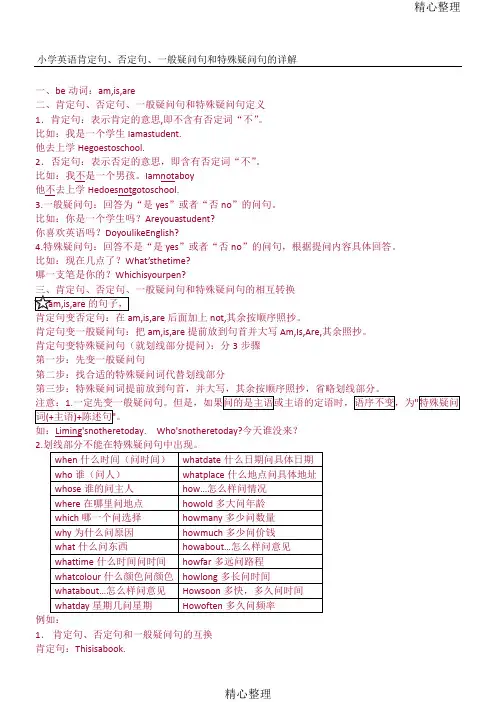
精心整理小学英语肯定句、否定句、一般疑问句和特殊疑问句的详解一、be动词:am,is,are二、肯定句、否定句、一般疑问句和特殊疑问句定义1.肯定句:表示肯定的意思,即不含有否定词“不”。
比如:我是一个学生Iamastudent.他去上学Hegoestoschool.2.否定句:表示否定的意思,即含有否定词“不”。
比如:我不是一个男孩。
Iamnotaboy例如:1.肯定句、否定句和一般疑问句的互换肯定句:Thisisabook.否定句:一般疑问句:Isthisabook?肯定回答:Yes,itis.否定回答:No,itisn’t.2.就划线部分提问(变特殊疑问句)Thisisabook.第一步:变一般疑问句Isthisabook?第二步:找合适的特殊疑问词Isthiswhat?第三步:特殊疑问词提前放到句首,并大写,其余按顺序照抄,省略划线部分。
Whatisthis?donot或者doesnot,其余按顺序照抄动词用原形do或者does并大写,其余照抄。
注意:动词用原形Wouldyoulikesomeorangejuice?与此相关的一些不定代词如something,somebody等也要进行相应变化。
2.and变为or。
如:Ihaveaknifeandar uler.→Idon'thaveaknifeoraruler.3.alotof(=lotsof)变为many或much。
如:Theyhavealotoffriends.(可数名词)→Theydon'thavemanyfriends.Thereislotsoforangeinthebottle.(不可数名词)→Thereisn'tmuchorangeinthebottle.4.already变为yet。
如:Ihavebeentherealready.→Ihaven't beenthereyet.小学英语肯定句、否定句、一般疑问句和特殊疑问句的转换练习一、就划线部分提问。
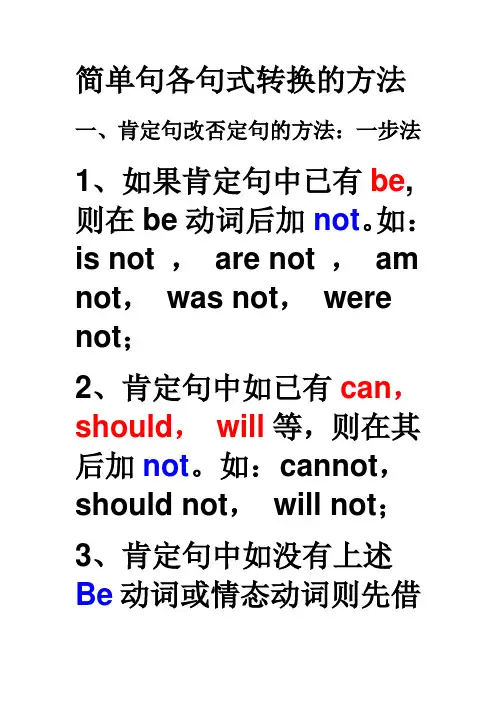
简单句各句式转换的方法一、肯定句改否定句的方法:一步法1、如果肯定句中已有be,则在be动词后加not。
如:is not ,are not ,am not,was not,were not;2、肯定句中如已有can,should,will等,则在其后加not。
如:cannot,should not,will not;3、肯定句中如没有上述Be动词或情态动词则先借助动词do/does/did的否定don’t/doesn’t/didn’t。
4、肯定句中如有some则改成any。
eg:把下面的句子变成否定句。
1.She is watching TV now.2.We go to schoolonSunday.3.His father works hard.4.Jack's mother is a nurse.5.The cat runs fast.6.They like readingbooks.7.My grandpa gives mea hot dog.8.Tom often walks to school.9.I have a doll.10.It is eating fish.二、肯定句改一般疑问句的方法——三步法1、肯定句中有be动词时,把be动词提到句首,剩下(some 改成any,的照抄,my改成your等)句号改成问号。
2、肯定句中已有can,shall,will等时,则把这些词放到句首,剩下的照抄,(some 改成any,my改成your等)句号改成问号。
3、如果肯定句中没有上述单词,则在句首借助动词Do/Does/Did帮忙,把后面的动词变为原形,剩下(some 改成any,的照抄,my改成your等)句号改成问号。
eg: They are in the park.He can play theguitar.Are they in the park? Can he play the guitar?I like the ducks.He likes the dogs.Do you like the ducks? Does he like the dogs? 把下列句子变成一般疑问句1. I am listening to music.2. Mike is a student.3. Sarah can clean the classroom.4. They are in the zoo.5. There are someflowers in the vase.6.This is my sister.7.We are sweeping the floor.8. We need somemasks.9. They like making the puppet.10. Su Hai and Su Yanglive in a new house. 11.I put a book on my head.12. They sing “In the classroom”together. 13.We play basketball on Sundays.14. Tom likes listening to music.三、肯定句改特殊疑问句的方法——四步法1、在一般疑问句的基础上,句首添加一个特殊疑问词即可,特殊疑问词可根据划线部分确定(即:特殊疑问词+一般疑问句构成特殊疑问句,但注意:Which, whose,how many除外,必须先在这些词后加名词,再加一般问句。
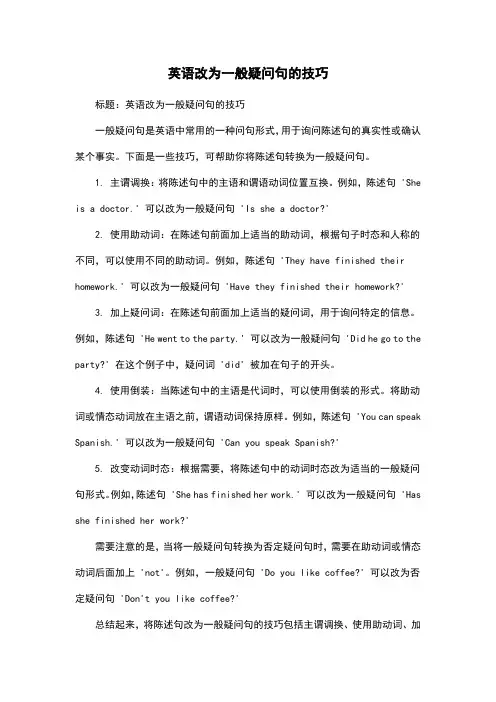
英语改为一般疑问句的技巧标题:英语改为一般疑问句的技巧一般疑问句是英语中常用的一种问句形式,用于询问陈述句的真实性或确认某个事实。
下面是一些技巧,可帮助你将陈述句转换为一般疑问句。
1. 主谓调换:将陈述句中的主语和谓语动词位置互换。
例如,陈述句 'She is a doctor.' 可以改为一般疑问句 'Is she a doctor?'2. 使用助动词:在陈述句前面加上适当的助动词,根据句子时态和人称的不同,可以使用不同的助动词。
例如,陈述句 'They have finished their homework.' 可以改为一般疑问句 'Have they finished their homework?'3. 加上疑问词:在陈述句前面加上适当的疑问词,用于询问特定的信息。
例如,陈述句 'He went to the party.' 可以改为一般疑问句 'Did he go to the party?' 在这个例子中,疑问词 'did' 被加在句子的开头。
4. 使用倒装:当陈述句中的主语是代词时,可以使用倒装的形式。
将助动词或情态动词放在主语之前,谓语动词保持原样。
例如,陈述句 'You can speak Spanish.' 可以改为一般疑问句 'Can you speak Spanish?'5. 改变动词时态:根据需要,将陈述句中的动词时态改为适当的一般疑问句形式。
例如,陈述句 'She has finished her work.' 可以改为一般疑问句 'Has she finished her work?'需要注意的是,当将一般疑问句转换为否定疑问句时,需要在助动词或情态动词后面加上 'not'。
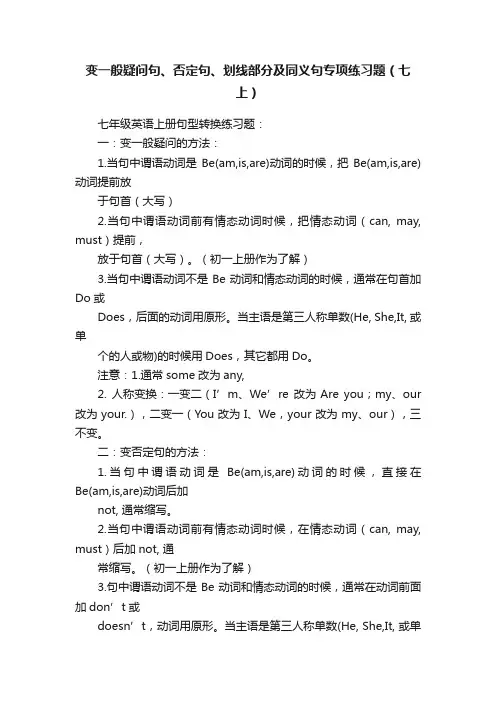
变一般疑问句、否定句、划线部分及同义句专项练习题(七上)七年级英语上册句型转换练习题:一:变一般疑问的方法:1.当句中谓语动词是Be(am,is,are)动词的时候,把Be(am,is,are)动词提前放于句首(大写)2.当句中谓语动词前有情态动词时候,把情态动词(can, may, must)提前,放于句首(大写)。
(初一上册作为了解)3.当句中谓语动词不是Be动词和情态动词的时候,通常在句首加Do或Does,后面的动词用原形。
当主语是第三人称单数(He, She,It, 或单个的人或物)的时候用Does,其它都用Do。
注意:1.通常some改为any,2. 人称变换:一变二(I’m、We’re 改为Are you;my、our 改为your.),二变一(You改为I、We,your改为my、our),三不变。
二:变否定句的方法:1.当句中谓语动词是Be(am,is,are)动词的时候,直接在Be(am,is,are)动词后加not, 通常缩写。
2.当句中谓语动词前有情态动词时候,在情态动词(can, may, must)后加not, 通常缩写。
(初一上册作为了解)3.句中谓语动词不是Be动词和情态动词的时候,通常在动词前面加don’t或doesn’t,动词用原形。
当主语是第三人称单数(He, She,It, 或单个的人或物)的时候用doesn’t,其它都用don’t.三: 对划线部分提问的方法:一定:定特殊疑问词,即根据划线部分内容确定特殊疑问词。
二改:把剩下的句子改为一般疑问句。
专项练习:1.变一般疑问句及回答:1.I’m Helen. (变一般疑问句并作肯定回答)__________ ____________ Helen?Yes, ___________ ____________.2.He is Jack. (变一般疑问句并作否定回答)___________ _____________Jack?No, ____________ ___________.3.My name is Kevin. (变一般疑问句)__________ ___________ name Kevin?4.My telephone number is 024---88888666. (变一般疑问句)_________ _______ telephone number 024—88888666? 5.This is my sister. (变一般疑问句)_________ _______ your sister?6.Those are my brothers. (变一般疑问句)_________ _______ your brothers?7.That is my pencil. (变一般疑问句并作肯定回答)_________ that _______pencil?Yes,_________ ___________.8.These are my books. (变一般疑问句并作否定回答)_________ _______your books?No, __________ ____________.9.My key is under the desk. (变一般疑问句)_________ _______ key under the desk?10.I have a soccer ball. (变一般疑问句并作肯定回答)_________ _______have a soccer ball?Yes,________ __________.11.They have 2 basketballs. (变一般疑问句,并作否定回答)_________ _______ have 2 basketballs?No,___________ __________.12.She has a ping-pong bat. (变一般疑问句,并作肯定回答)_________ she _______ a ping-pong bat?Yes,_________ __________.13.Tom likes bananas. (变一般疑问句,并作肯定回答)________Tom _______bananas?Yes,_________ _________.14.David asks the volleyball star about her eating habits. (变一般疑问句)_______David _______the volleyball star about her eating habit?15.I need a sweater for school. (变一般疑问句)_________ you _______ a sweater for school?16.We sell all our clothes at very good prices. (变一般疑问句)_________ you _______all your clothes at very good prices?17.My birthday is on May 6th . (变一般疑问句)_________ _______ birthday on May 6th ?18.My favorite subject is science. (变一般疑问句)_________ _______favorite subject science?19.She likes Monday. (变一般疑问句)_________ she _______ Monday?2.变否定句:1.1. Her name is Linda. (改为否定句)Her ________ _________Linda.2.I’m Helen. (改为否定句)_______ _______Helen.3.This is my QQ number. (改为否定句)________ ________ my QQ number.4.They have a soccer ball. (改为否定句)They_________ _______a soccer ball.5.My sister has lunch at school. (改为否定句)My sister___________ ________lunch at school.6.Tom likes eggs for breakfast. (改为否定句)Tom_________ _______eggs for breakfast.7.They have a daughter. (改为否定句)They_________ ________ a daughter.8.I want to eat apples. (改为否定句)I ___________ _________ to eat apples.9.These are my brothers. (改为否定句)_________ _________ my brothers.10.T hey like to play ping-pong. (改为否定句)They_________ __________ to play ping-pong.11.T om and Lisa love to play with their friends. (改为否定句) Tom and Lisa _________ ______to play with their friends. 12.T om wants to play soccer with Kevin. (改为否定句)Tom_________ _______to play soccer with Kevin.13.T hey have English at 9:30 in the morning. (改为否定句) They__________ _______ English at 9:30 in the morning.14.S he and her friends are 12 years old. (改为否定句)She and her_______ _________12 years old.15.My book is on my desk. (改为否定句)My book________ __________ on my desk.16.S he has a ping-pong bat. (改为否定句)She_________ ________a ping-pong bat.17.I need a sweater for school. (改为否定句)I _______ ________ a sweater for school.18.I have some apples for breakfast. (改为否定句)I_________ have _______apples for breakfast.19.T hey eat well at home. (改为否定句) They______ _______ well at home.20.T hey buy some pencils. (改为否定句) They ________buy ________pencils.21.J ack has a Chinese friend. (改为否定句) Jack_________ ________ a Chinese friend.。
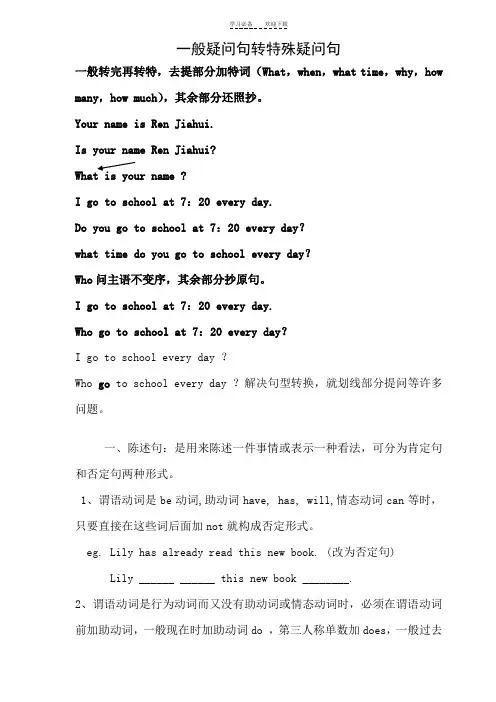
一般疑问句转特殊疑问句一般转完再转特,去提部分加特词(What,when,what time,why,how many,how much),其余部分还照抄。
Your name is Ren Jiahui.Is your name Ren Jiahui?What is your name ?I go to school at 7:20 every day.Do you go to school at 7:20 every day?what time do you go to school every day?Who问主语不变序,其余部分抄原句。
I go to school at 7:20 every day.Who go to school at 7:20 every day?I go to school every day ?Who go to school every day ?解决句型转换,就划线部分提问等许多问题。
一、陈述句:是用来陈述一件事情或表示一种看法,可分为肯定句和否定句两种形式。
1、谓语动词是be动词,助动词have, has, will,情态动词can等时,只要直接在这些词后面加not就构成否定形式。
eg. Lily has already read this new book. (改为否定句)Lily ______ ______ this new book ________.2、谓语动词是行为动词而又没有助动词或情态动词时,必须在谓语动词前加助动词,一般现在时加助动词do ,第三人称单数加does,一般过去时加did,再和not构成否定结构。
必须指出的是:don't, doesn't, didn't 后都用动词原形。
eg.1)Jill has lunch at school every day. (改为否定句)Jill _____ _____ lunch at school every day.2)The children had a good time at the party. (改为否定句) The children ______ _____ a good time at the party.3)Rose didn't drink any milk this morning.(改为肯定句) Rose ______ ______ milk this morning.二、疑问句:是用来提出问题的句子。
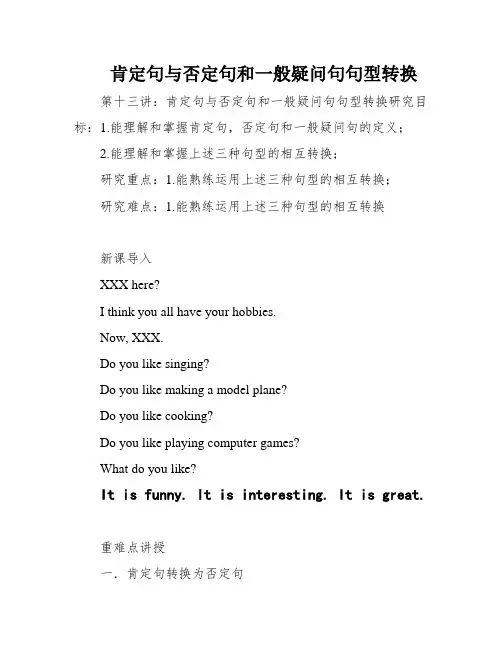
肯定句与否定句和一般疑问句句型转换第十三讲:肯定句与否定句和一般疑问句句型转换研究目标:1.能理解和掌握肯定句,否定句和一般疑问句的定义;2.能理解和掌握上述三种句型的相互转换;研究重点:1.能熟练运用上述三种句型的相互转换;研究难点:1.能熟练运用上述三种句型的相互转换新课导入XXX here?I think you all have your hobbies.Now, XXX.Do you like singing?Do you like making a model plane?Do you like cooking?Do you like playing computer games?What do you like?It is funny. It is interesting. It is great.重难点讲授一.肯定句转换为否定句1.含be动词(is/am/are)的否定(否定词is /am/are+not)(1) there be句型中的否认There is a cat in the tree._______________________________________There are some flowers in the garden.______________________________________XXX._______________________________________(2)人称代词She/ He/ It is a student._______________________________________ We/ They are your friends._______________________________________(3)指示代词This/ That is an English book._______________________________________XXX are very big and yellow. _______________________________________(4)名词,人名,地名,等名词性质类词。
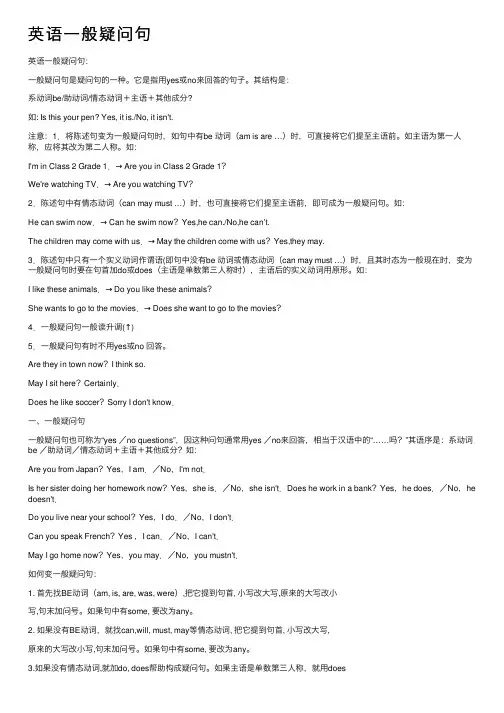
英语⼀般疑问句英语⼀般疑问句:⼀般疑问句是疑问句的⼀种。
它是指⽤yes或no来回答的句⼦。
其结构是:系动词be/助动词/情态动词+主语+其他成分?如: Is this your pen? Yes, it is./No, it isn't.注意:1.将陈述句变为⼀般疑问句时,如句中有be 动词(am is are …)时,可直接将它们提⾄主语前。
如主语为第⼀⼈称,应将其改为第⼆⼈称。
如:I'm in Class 2 Grade 1.→ Are you in Class 2 Grade 1?We're watching TV.→ Are you watching TV?2.陈述句中有情态动词(can may must …)时,也可直接将它们提⾄主语前,即可成为⼀般疑问句。
如:He can swim now.→ Can he swim now?Yes,he can./No,he can’t.The children may come with us.→ May the children come with us?Yes,they may.3.陈述句中只有⼀个实义动词作谓语(即句中没有be 动词或情态动词(can may must …)时,且其时态为⼀般现在时,变为⼀般疑问句时要在句⾸加do或does(主语是单数第三⼈称时),主语后的实义动词⽤原形。
如:I like these animals.→ Do you like these animals?She wants to go to the movies.→ Does she want to go to the movies?4.⼀般疑问句⼀般读升调(↑)5.⼀般疑问句有时不⽤yes或no 回答。
Are they in town now?I think so.May I sit here?Certainly.Does he like soccer?Sorry I don't know.⼀、⼀般疑问句⼀般疑问句也可称为“yes /no questions”,因这种问句通常⽤yes /no来回答,相当于汉语中的“……吗?”其语序是:系动词be /助动词/情态动词+主语+其他成分?如:Are you from Japan?Yes,I am./No,I'm not.Is her sister doing her homework now?Yes,she is./No,she isn't.Does he work in a bank?Yes,he does./No,he doesn't.Do you live near your school?Yes,I do./No,I don't.Can you speak French?Yes ,I can./No,I can't.May I go home now?Yes,you may./No,you mustn't.如何变⼀般疑问句:1. ⾸先找BE动词(am, is, are, was, were),把它提到句⾸, ⼩写改⼤写,原来的⼤写改⼩写,句末加问号。
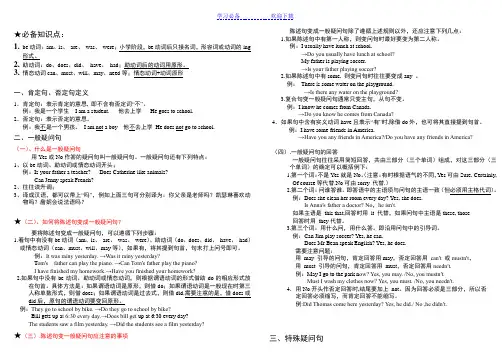
★必备知识点:1.be动词:am、is、are、was、were;小学阶段,be动词后只接名词,形容词或动词的ing形式。
2.助动词:do、does、did、have、had;助动词后的动词用原形。
3.情态动词can、must、will、may、need等;情态动词+动词原形一、肯定句、否定句定义1.肯定句:表示肯定的意思, 即不含有否定词“不”。
例:我是一个学生I am a student. 他去上学He goes to school.2.否定句:表示否定的意思。
例:我不是一个男孩。
I am not a boy 他不去上学He does not go to school.二、一般疑问句(一)、什么是一般疑问句用Yes或No作答的疑问句叫一般疑问句。
一般疑问句还有下列特点:1、以be动词、助动词或情态动词开头;例:Is your father a teacher? Does Catherine like animals?Can Jenny speak French?2、往往读升调;3、译成汉语,都可以带上“吗”,例如上面三句可分别译为:你父亲是老师吗?凯瑟琳喜欢动物吗?詹妮会说法语吗?★(二)、如何将陈述句变成一般疑问句?要将陈述句变成一般疑问句,可以遵循下列步骤:1.看句中有没有be动词(am、is、are、was、were)、助动词(do、does、did、have、had)或情态动词(can、must、will、may等),如果有,将其提到句首,句末打上问号即可。
例:It was rainy yesterday. →Was it rainy yesterday?T om's father can play the piano. →Can Tom's father play the piano?I have finished my homework.→Have you finished your homework?2.如果句中没有be动词、助动词或情态动词,则根据谓语动词的形式借助do的相应形式放在句首。
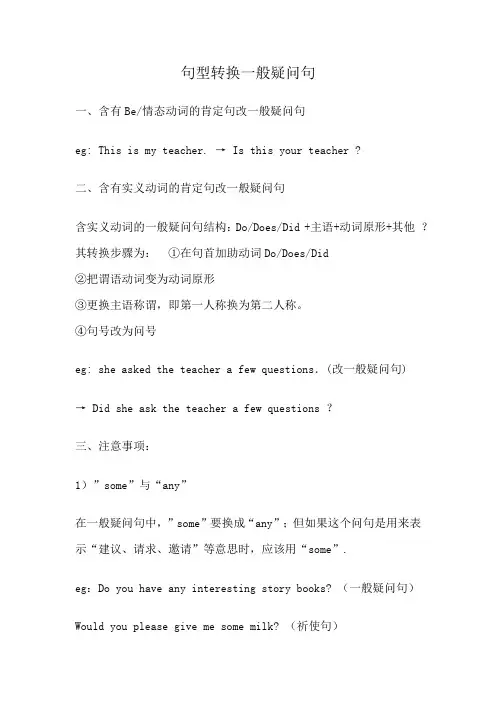
句型转换一般疑问句
一、含有Be/情态动词的肯定句改一般疑问句
eg: This is my teacher. → Is this your teacher ?
二、含有实义动词的肯定句改一般疑问句
含实义动词的一般疑问句结构:Do/Does/Did +主语+动词原形+其他?其转换步骤为:①在句首加助动词Do/Does/Did
②把谓语动词变为动词原形
③更换主语称谓,即第一人称换为第二人称。
④句号改为问号
eg: she asked the teacher a few questions.(改一般疑问句)
→ Did she ask the teacher a few questions ?
三、注意事项:
1)”some”与“any”
在一般疑问句中,”some”要换成“any”;但如果这个问句是用来表示“建议、请求、邀请”等意思时,应该用“some”.
eg:Do you have any interesting story books? (一般疑问句)Would you please give me some milk? (祈使句)
2)在一般疑问句中,类似需要改变的单词有:“something”➸“anything”, “somebody”➸“anybody”,
“already”➸“yet”等。
一般疑问句和特殊疑问句的转换一、be动词:am, is, are二、一般疑问句和特殊疑问句定义1. 一般疑问句:回答为“是yes”或者“否no”的问句。
比如:你是一个学生吗? Are you a student?你喜欢英语吗? Do you like English?2. 特殊疑问句:回答不是“是yes”或者“否no”的问句,根据提问内容具体回答。
比如:现在几点了? What’s the time?哪一支笔是你的? Which is your pen?三、一般疑问句的转换1、先找be动词 am, is, are, was, were或情态动词can, may ,must, would,should ,could .如果有这些词,直接把这些词放在句子最前面, some 改成any,句号改成问号!其余照抄;(如果主语是第一人称则变成第二人称)2、如果句子中没有be动词或者是情态动词,要在句子最前面加助动词 do 、does或者是did。
A.首先判断句子时态,如果句子是过去式,则要在句最前面加Did,后面动词用原型,some改成any,句号改成问号,其余照抄;(如果主语是第一人称则变成第二人称)B.如果句子不是过去式,则判断是否为第三人称单数,如果第三人称单数,要在句子最前面前加助动词Does,后面动词用原型,some 改成any,句号改成问号,其余部分照抄。
(如果主语是第一人称则变成第二人称)其他情况均要在句子最前面加助动词do,some改成any,句号改成问号,其它部分照抄. (如果主语是第一人称则变成第二人称)一般疑问句也可称为“yes /no questions”,因这种问句通常用yes / no来回答,相当于汉语中的“……吗?”其语序是:系动词be /助动词/情态动词+主语+其他成分?如:Are you from Japan?Yes I am./ No I'm not.Is her sister doing her homework now?Yes she is./ No she isn't.Does he work in a bank?Yes he does./ No he doesn't.Do you live near your school?Yes I do./ No I don't.Can you speak French?Yes I can./ No I can't.将下列句子改为一般疑问句:1 They are my good friends.2. She is listening to the music now.3. His parents were in the USA last week.4. You can take bus No. 9 to get there.5. She would like to read these new words.特殊疑问句一般有以下疑问词when 什么时间(问时间)what date 什么日期问具体日期who 谁(问人)what place什么地点问具体地址whose 谁的问主人how …怎么样问情况where 在哪里问地点how old 多大问年龄which 哪一个问选择how many 多少问数量why 为什么问原因how much 多少问价钱what 什么问东西how about …怎么样问意见what time 什么时间问时间how far 多远问路程what colour 什么颜色问颜色how long 多长问时间what about…怎么样问意见How soon 多快,多久问时间what day 星期几问星期How often多久问频率肯定句变特殊疑问句(就划线部分提问):分3步骤第一步:先变一般疑问句第二步:找合适的特殊疑问词代替划线部分第三步:特殊疑问词提前放到句首,并大写,其余按顺序照抄,省略划线部分。
英语:句型转换口诀句型变化很简单,/ 先把句中动词看:/ be may must will can,/ 否定句not加后边。
/ 一般问句也不难,/ 助情动词放句前;/ 两种回答yes no,/ 句首动词人后面。
/ 没有现成怎么办?/ do does did 来相伴,/ 三单式过去要还原。
/ 特殊问句更简单,/ 疑问词后跟一般。
/ 事物职业等what,/ who人where问地点,/ whose谁的所有权。
/ 数量how many复后边,/ how much不可数和价钱。
/ why问原因慢慢谈,/ what time when时间,/ how old岁数多少年?/ how be人身永康健!例析上述口诀表明:句型变化的关键是识别和取决于句中的动词。
如果句中有现成的be ,have,used,may ,must ,will ,can等助动词或情态动词,则在其后直接加上not即构成否定句;将其提于句首则成为一般疑问句,在简略回答中,除there be句型外,在yes或no后边一般要使用“人称代词主格+助动词或情态动词成分”,其中的助动词或情态动词应该与问句保持一致。
例如,(1) Tha t’s her grandfather over there(改为否定句和一般疑问句并回答)。
根据口诀,我们发现句中有现成的be动词is ,不需要其他的助动词来协助,故本句的否定句为:That’s not her grandfather over there;一般疑问句及回答为:Is that her grandfather over there?Y es,he is;/ No,he isn’t. (2) Tom used to read Chinese histories.(改为否定句和一般疑问句并回答),句中的used是一个突破口,故否定句为Tom used not to read Chinese histories;一般问句和回答为Used Tom to read Chinese histories ?Y es,he used;/ No,he usedn’t. 但根据传统习惯,本句也可以将used 视为行为动词use的过去式,故其否定句和一般疑问句及回答分别是Tom didn’t use to read Chinese histories和Did Tom use to read Chinese histories ?Y es,he did;No,he didn’t .“没有现成怎么办”指的是句中没有be ,have,used,may ,must ,will ,can 等助动词或情态动词的情况。
转一般疑问句
转一般疑问句是英语语法中的一种转换方式,用于将陈述句转换为疑问句。
在转换过程中,需要将陈述句中的助动词或be动词移至句首,并在句末加上问号。
下面将通过例句来解释如何转换一般疑问句。
1.陈述句:He is a teacher.
疑问句:Is he a teacher?
2.陈述句:They have finished their homework.
疑问句:Have they finished their homework?
3.陈述句:She can play the piano.
疑问句:Can she play the piano?
4.陈述句:We should go to the meeting.
疑问句:Should we go to the meeting?
5.陈述句:I am going to the store.
疑问句:Am I going to the store?
通过上述例句,可以看出转换一般疑问句的方法是将陈述句中的助动词或be动词移至句首,然后在句末加上问号。
需要注意的是,如果陈述句中没有助动词或be动词,那么需要根据上下文来确定应该使用什么助动词或be动词进行转换。
总结来说,转一般疑问句是英语语法中的一种转换方式,用于将陈述句转换为疑问句。
在转换过程中要注意将助动词或be动词移至句首,并在句末加上问号。
希望这篇文章对你有所帮助,如果有其他问题,请随时提问。
肯定句否定句和一般疑问句的转换方法解析肯定句、否定句和一般疑问句是英语语法中常见的句子类型,掌握它们的转换方法可以帮助我们更好地理解和运用英语。
本文将对肯定句、否定句和一般疑问句的转换方法进行解析。
1. 肯定句转换为否定句在将肯定句转换为否定句时,需要在句子中添加一个否定词。
常见的否定词包括"not"、"no"和"never"等。
例如,将肯定句"I like apples."转换为否定句,可以加入否定词"not",变为"I do not like apples."2. 否定句转换为肯定句将否定句转换为肯定句的方法是去掉否定词,并对句子进行结构上的调整。
例如,将否定句"I don't like coffee."转换为肯定句,去掉否定词"don't",并将句子结构调整为倒装结构,变为"Like coffee, I do."3. 肯定句和否定句转换为一般疑问句将肯定句和否定句转换为一般疑问句的方法是将句子的主语和助动词(be动词、情态动词或助动词do/does/did)进行调换。
例如,将肯定句"He is a student."转换为一般疑问句,将主语"he"和助动词"is"进行调换,变为"Is he a student?"同样地,将否定句"I don't like dogs."转换为一般疑问句,将主语"I"和助动词"don't"进行调换,变为"Do you like dogs?"4. 一般疑问句转换为肯定句和否定句将一般疑问句转换为肯定句和否定句的方法是根据问句的答案进行回答。
小学英语句型转换方法归纳:肯定句、否定句、一般疑问句与特殊疑问句1、肯定句:是指用肯定的语气来陈述的句子,如:I’m a student. She is a doctor. He works in a hospital. There are four fans in our classroom..2、否定句:含有否定词或表示否定意义词的句子,如:I’m not a student. She is not (isn’t) a doctor. He does not (doesn’t) work in a hospital. There are not (aren’t) four fans in our classroom.☆注意小结:否定句主要是在肯定句的基础上加上了否定词“not”。
有动词be的句子则“not”加在be后面,可缩写成“isn’t,aren’t”,但am not 一般都分开写。
没有动词be的句子则要先在主要动词的前面加上一个助动词(do,does,did),然后在它后面加上“not”,你也可以把它们缩写在一起如“don’t , doesn’t , didn’t )。
这三个助动词要根据人称和时态来选择,其中“does”只用于一般现在时主语是第三人称单数的情况,而“did”只用于一般过去时,不论主语是什么人称和数,都用“did” 。
3、一般疑问句:是指询问事实的句子,此类句子必须用“yes”,或“no”来回答。
如:Are you a student? Yes, I am / No, I’m not.Is she a doctor? Yes, she is. / No, she isn’t.Does he work in a hospita l? Yes, he does. / No, he doesn’t.Are there four fans in our classroom? Yes, there are. / No, there aren’t.☆注意小结:一般疑问句是在肯定句的基础上:①把动词be调到首位,其他照写,末尾标点符号变成问号即可。
一般疑问句改法
一般疑问句改法通常是将陈述句转换为疑问句,以下是一些基本的步骤和注意事项:
1. 确定动词:在句子中找到动词,这通常是句子中的主要动作。
2. 情态动词放句首:在找到的动词前面添加适当的情态动词,如“can”、“will”、“should”、“have”等。
这些情态动词可以表达出句子中的意愿、可能性或完成性。
3. 借助助动词Do/Does/Did:如果动词是第一人称单数或非第三人称单数形式,可以在动词前面添加助动词“Do”;如果是第三人称单数形式,可以添加助动词“Does”;如果是过去时态,可以添加助动词“Did”。
4. 单词大写:将句子的第一个单词的首字母大写,这是英语语法的基本要求。
5. 结尾用问号:在句子的结尾使用问号,表示这是一个疑问句。
6. 语序要调整:通常需要将句子中的主语和谓语的位置调换,将谓语放在主语之前。
7. 一般疑问句翻译成汉语都是以“是吗”的形式来结尾的,这类问句也是问一些肯定的概念,并没有明确的“是”或“否”作为回复,它代表任何一种可能的答案都是被接受的。
下面是一个例子:
陈述句:The sun rises in the east.
改写成一般疑问句:Does the sun rise in the east?
在这个例子中,动词是“rises”,我们添加了助动词“Does”,并将情态动词“Can”放在了句首。
同时,我们将主语“The sun”和谓语“rises”的位置调换,并在结尾使用了问号。
最后,翻译成汉语时添加了“是吗”。
小英说:在小学英语学习中,句型转换这部分是很多小朋友的“薄弱项”,今天我们把句型转换(陈述句变成一般疑问句)系统得总结一下,供同学们参考学习。
句型转换
(陈述句变成一般疑问句)
1. 什么是一般疑问句?
一般疑问句用于对某一情况提出疑问,通常用yes和no来回答,读时用声调。
2. 变一般疑问句的方法:
A:把句子中的be动词提到句首(be动词包括:am is are)
例如:I am a student.→Are you a student?
S he is a teacher.→Is she a teacher?
They are good friends.→ Are they good friends?
B:把句子中的情态动词提到句首(情态动词包括can may must will should等)
例如:She can play football.→ Can she play football?
I will help you. → Will you help me?
C:如果句子中没有be动词和情态动词,就要在句首加上助动词帮助其变成一般疑问句。
(情态动词包括do和does)
主语是第一、二人称和复数人称时在句首加上Do;
主语是第三人称单数形式时加Does。
加上Does之后,原来句子中的三单形式要还原。
人称:第一人称:单数:I 复数:we
第二人称:单数:you 复数:you
第三人称:单数:she、he、it以及人名复数:they
例如:You have a friend. → Do you have a friend?
She likes apples. → Does she like apples?
Amy does her homework at home.
→ Does Amy do her homework at home?
注意:
1.句点变问号;
2.句子中的第一人称和第二人称互换;
I can help you . → Can you help me?
3.some→ any;
I have some apples. →Do you have any apples?
4.动词的三单形式还原问题。
She goes to school on foot. →Does she go to school on foot?专项练习
将下列句子改成一般疑问句并回答。
1. It is a lovely dog.
2. She is a lovely girl.
3. He is my father.
4. They are Lily’s cousins.
5. We are classmates.
6. I am a doctor.
7 There is a bird in the tree.
8.There are many stars in the sky.
9. They are good friends.
10. I love my parents.
11. We have a pleasant home.
12. We like to climb the mountain.
13. They go to church on Sunday.
14. They walk to school every morning.
15. I can swim.
参考答案
1.Is it a lovely dog? Yes,it is . No, it isn’t.
2.Is she a lovely girl ? Yes,she is . No, she isn’t.
3.Is he your father? Yes,he is . No, he isn’t.
4.Are they Lily’s cousins? Yes,they are. No, they aren’t.
5.Are you classmates? Yes,we are. No, we aren’t.
6. Are you a doctor? Yes , I am . No, I’m not.
7.Is there a bird in the tree? Yes ,there is . No, there isn’t.
8. Are there many stars in the sky ? Yes ,there are . No, there aren’t.
9. Are they good friends? Yes,they are. No, they aren’t.
10. Do you love your parents? Yes,I do. No,I don’t.1
1. Do you have a pleasant home? Yes,I do. No,I don’t.
12. Do you like to climb the mountain? Yes,I do. No,I don’t.
13. Do they go to church on Sunday? Yes,they do. No,they don’t
14.Do they walk to school every morning? Yes,they do. No,they don ’t.
15.Can you swim? Yes,I can. No, I can’t
(注:专业文档是经验性极强的领域,无法思考和涵盖全面,素材和资料部分来自网络,供参考。
可复制、编制,期待你的好评与关注)。